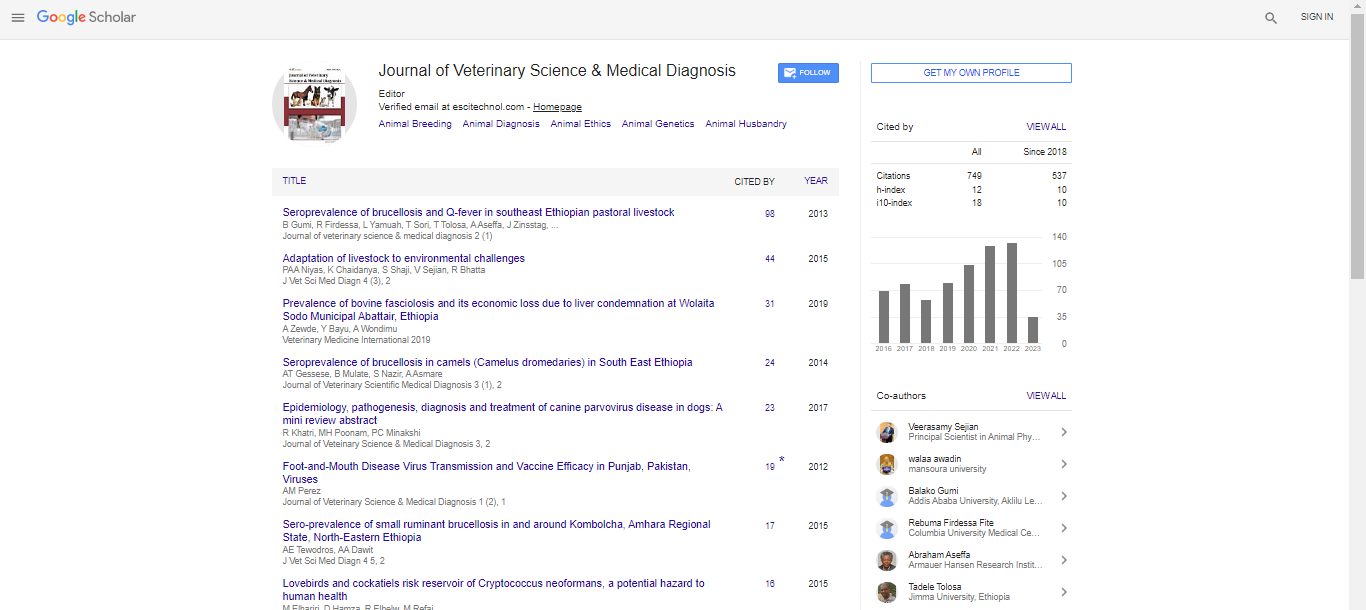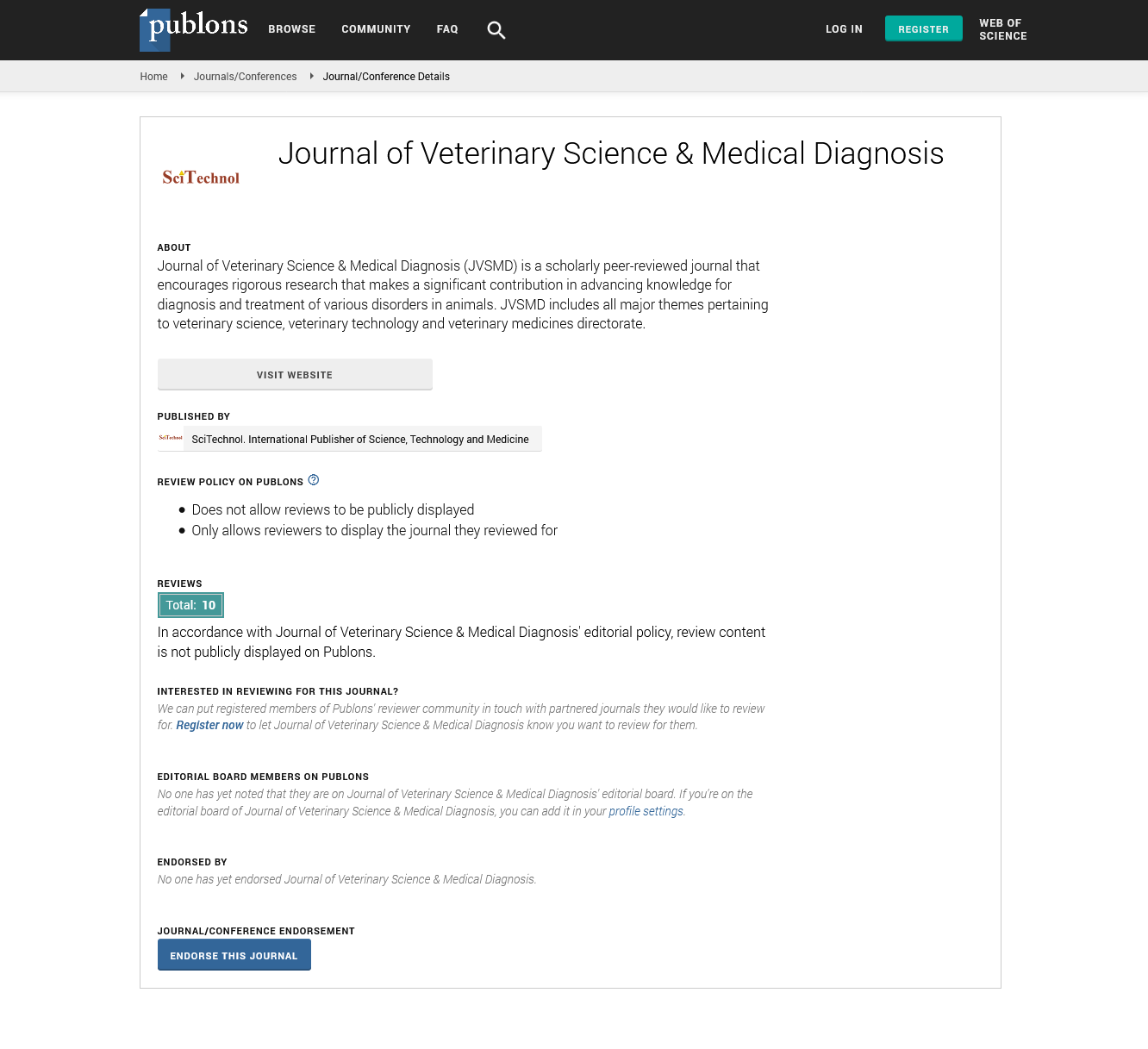Commentary, J Vet Sci Med Diagn Vol: 13 Issue: 4
Veterinary Physiology Explained: Understanding the Science of Animal Function
Catherine Young*
1Department of Veterinary Pathology, University of Liverpool, Neston, UK
*Corresponding Author: Catherine Young,
Department of Veterinary Pathology,
University of Liverpool, Neston, UK
E-mail: catheriney@gmail.com
Received date: 19 June, 2024, Manuscript No. JEEET-24-144729;
Editor assigned date: 21 June, 2024, Pre QC No. JEEET-24-144729 (PQ);
Reviewed date: 5 July, 2024, QC No. JEEET-24-144729;
Revised date: 12 July, 2024, Manuscript No. JEEET-24-144729 (R);
Published date: 19 July, 2024, DOI: 10.4172/2324-83414.1000107
Citation: Young C (2024) Veterinary Physiology Explained: Understanding the Science of Animal Function. J Vet Sci Med Diagn 13:2.
Description
Veterinary physiology is a foundation of veterinary science, providing difficult insights into how animals' bodies function and respond to various stimuli. This field explores the mechanisms underlying the physiological processes that keep animals healthy, from cellular functions to complex organ systems. Understanding these principles is essential for diagnosing and treating diseases, developing effective therapies and ensuring overall animal welfare.
The fundamentals of animal physiology
Veterinary physiology delves into the study of bodily functions in animals, focusing on how different systems interact to maintain homeostasis the body's stable internal environment. It encompasses a broad range of topics, including the function of organs, tissues, and cells, as well as the regulatory mechanisms that sustain life. One key aspect of veterinary physiology is the examination of how organs and systems work together to support life. For example, understanding the cardiovascular system's role in delivering oxygen and nutrients throughout the body helps veterinarians diagnose and treat conditions such as heart disease and hypertension.
Similarly, knowledge of the respiratory system's function in gas exchange is important for managing respiratory disorders like asthma and pneumonia. Veterinary physiology also explores how the nervous system controls and coordinates bodily functions. This includes studying the brain, spinal cord and peripheral nerves to understand how animals perceive their environment, respond to stimuli, and maintain balance and coordination. Disorders of the nervous system, such as epilepsy or paralysis, can be better managed with a thorough understanding of these physiological processes.
Applications in diagnosis and treatment
A solid grasp of veterinary physiology is vital for applying this knowledge in clinical settings. It helps veterinarians interpret diagnostic tests, understand disease mechanisms and develop effective treatment plans. For instance, knowledge of renal physiology allows veterinarians to assess kidney function through blood tests and urine analysis, aiding in the diagnosis of renal diseases and guiding appropriate treatments. Pharmacology, or the study of how drugs interact with the body, is another area where veterinary physiology plays a important role. Understanding how medications are absorbed, distributed, metabolized, and excreted helps veterinarians prescribe the correct dosages and minimize side effects.
For example, knowing how a drug affects the gastrointestinal system can influence decisions about administering it with or without food. Veterinary physiology also informs preventive care strategies. By understanding normal physiological processes, veterinarians can better identify early signs of disease and implement preventive measures. This knowledge is applied in routine health screenings, vaccination programs and dietary recommendations, all aimed at maintaining optimal health and preventing illness.
Advancements and future directions
The field of veterinary physiology is continually evolving, with ongoing research providing new insights into animal health and disease. Advances in technology, such as imaging techniques and molecular biology, have enhanced our understanding of physiological processes and their alterations in disease states. For example, advanced imaging allows for non-invasive observation of internal structures and functions, aiding in the diagnosis and management of various conditions. Emerging areas of research, such as comparative physiology, explore how physiological processes differ among species, offering valuable insights into animal-specific health issues and treatment strategies.
This comparative approach helps tailor medical interventions to the unique physiological needs of different animals, improving treatment outcomes and overall care. In conclusion, veterinary physiology is a fundamental aspect of veterinary science, providing essential knowledge about how animals' bodies function and respond to various conditions. By understanding the intricate details of physiological processes, veterinarians can diagnose diseases more accurately, develop effective treatments and implement preventive measures to enhance animal health. As research and technology continue to advance, veterinary physiology will remain a difficult field in improving our understanding of animal health and delivering highquality care.
 Spanish
Spanish  Chinese
Chinese  Russian
Russian  German
German  French
French  Japanese
Japanese  Portuguese
Portuguese  Hindi
Hindi 
